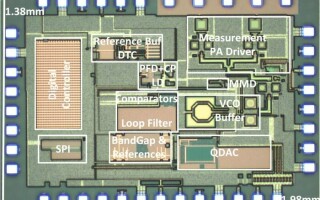Imec Reveals Low-Power Phase-Locked Loop for Short-Range Automotive and Industrial Radar Applications
February 22, 2023
News

LEUVEN (Belgium) — imec recently announced a digitally calibrated charge-pump (CP) phase-locked loop (PLL) capable of generating high-quality frequency-modulated continuous-wave (FMCW) signals for mmWave radars.
Operating at a low power consumption, the PLL can be utilized in future short-range automotive and industrial radar applications. “Applications include in-cabin radar sensors to monitor presence, movements, and well-being of driver and passengers, as well as out-of-cabin sensors for parking assistance or vehicle detection,” explains Ilja Ocket, Program Manager at imec.
FMCW mmWave-based radar sensors are designed to transmit a sinusoidal wave whose frequency increases linearly in time, a sweep referred to as ‘chirp.’ Following reflection by the object, the signal is carried out by the receiver and combined with the original chirp signal, after which the object’s distance and speed can be extracted. The quality of the radar signal depends heavily on the performance of the PLL used to generate the chirp signal.
Imec’s PLL is designed to generate highly linear, high-quality chirp signals centered around 16GHz with a chirp bandwidth of 1.5GHz. The solution is able to reach chirp speeds down to 12µs, with as low as 41kHzrms error in frequency modulation (rms-FM-error). The PLL enables an ideal startup (below 1µs) and suitable reset time between chirps (1µs reset time). The chirp generator operates in duty-cycled mode – synthesizing N chirps in one burst before powering down – providing power savings.
As an example of the aforementioned process, the PLL consumes only 9.2mW and 1.48mW when operating in a 50 percent and one percent duty-cycled mode, respectively. Still, after power-down mode, the rms-FM-error of the first chirp remains below 41kHz. The duty cycling performance was enabled by adopting a charge-pump (CP)-based PLL architecture, fabricated in 28nm CMOS technology and extended with a phase-offset compensation time-to-digital convertor (POC-DTC) to facilitate self-calibration.
Per the company, there parameters make the PLL ideal for short-range automotive radar applications with a range of up to several tens of meters.
According to Ilja Ocket, Program Manager at imec, “Our PLL also opens doors to robotics radar applications – think of on-cobot radar sensors to enhance safety and efficiency of human-robot interaction in industrial environments – as well as to radar sensors mounted on small moving objects or vehicles such as drones. At ISSCC, we are presenting a functional demo that integrates our CP-PLL with imec’s existing 140GHz radar receiver and transmitter blocks to showcase the potential of the technology for future automotive and industrial applications. The PLL can also be used for up-conversion to mmWave radar signals with other carrier frequencies, e.g., 80GHz.”
.jpg)
Micrograph of the CP-PLL die with below 0.6mm2 active core area (PFD=phase-frequency detector; VCO=voltage-controlled oscillator; QDAC= charge-integrating digital-to-analog converter).
For more information, visit: www.imec-int.com




